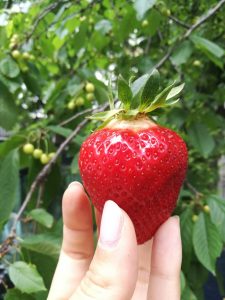Strawberries are a fruit that can be planted throughout the year, but due to climate change, the autumn months have become optimal for planting. A few decades ago, planting strawberries in autumn was almost unthinkable, but today it is a recommended practice, because autumn planting is safer than spring planting. Soon after planting, the plants enter the resting phase, which allows for better rooting and a stronger start of vegetation in the spring. Fruit growers claim that the yields of autumn plantings of strawberries are higher compared to plantings raised in the spring.

Timely soil preparation is key to quality strawberry planting. Before planting, it is necessary to perform an agrochemical analysis of the soil. This analysis, which is carried out in the laboratory of the agricultural expert service, enables the precise determination of the content of basic elements such as nitrogen (N), phosphorus (P), potassium (K) and the pH value of the soil, as well as the presence of carbonates. This information is essential for the selection of strawberry varieties and the required amount of fertilizers, including manure and mineral fertilizers.
The soil for planting strawberries should be prepared when the humidity is moderate, in order to preserve its structure. Land preparation is especially important for those who plan to grow larger plants. Before plowing, it is necessary to evenly distribute burnt cow manure in the amount of 20 to 40 tons per hectare. Then plowing is done to a depth of about 30 cm. Alternatively, poultry manure, which is rich in macronutrients, can be used. Before planting, the soil is additionally enriched with mineral fertilizers (NPK), which are introduced by plowing to a depth of 30 to 40 cm. Usually between 700 and 1,000 kg of mineral fertilizer is needed per hectare.


How to plant strawberries?
Strawberries are usually planted on banks, that is, beds, which are covered with black foil. It is best to place the rows in a north-south direction, so that the plants are better exposed to the sun and to allow better ventilation. Planting can be done by hand, which is the more common practice, or by machine. If the seedlings (hedges) were bought in a nursery where they were kept in a cold room, they should be planted no later than three days after collection. Before planting, the seedlings should be soaked in water for 24 hours to refresh them, and then in a fungicide solution, usually copper-based, for disinfection.
After planting, each plant should be watered abundantly to speed up rooting. Strawberries require a lot of phosphorus and potassium, so they need to be fed with easily soluble fertilizers that contain both macro and microelements. It is recommended to use water-soluble fertilizers with a higher phosphorus content in the beginning, in order to strengthen the roots. After 7 to 10 days from planting, preference is given to fertilizers with a higher nitrogen content, which encourages vegetative growth. Later, fertilizers with a high potassium content are used for feeding, which encourages the flowering of strawberries.
Source: Good morning
Source: boljazemlja.com


